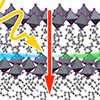| Dec 26, 2023 |
|
(Nanowerk News) A team led by RIKEN researchers has investigated how special crystals convert light into electricity (Angewandte Chemie, “Bulk photovoltaic effect along the nonpolar axis in organic-inorganic hybrid perovskites”). Their findings will help inform efforts to improve their efficiency, which could lead to the crystals being used in solar cells.
|
|
Solar cells convert light into electricity by a phenomenon known as the photovoltaic effect. The vast majority of solar cells consist of two semiconductors wedged together—one with an excess of electrons and the other being electron deficient. This is because the setup has a high conversion efficiency.
|
|
But another photovoltaic effect has also been attracting attention—the bulk photovoltaic effect, so called because it only involves a single material. While its conversion efficiency is currently rather low, recent research has suggested ways for improving its efficiency.
|
 |
| Schematic illustration of the bulk photovoltaic effect along the non-polar axis of the organic–inorganic hybrid perovskite. The yellow arrow represents of a photon of light, while the blue and green clouds show an electron and a hole, respectively. The red arrow is the polarization axis. (© WILEY-VCH Verlag)
|
|
There has been much debate about how the bulk photovoltaic effect works. It was originally thought that an electric field generated by polarizations within the material gave rise to the effect, but a new explanation has recently been gaining currency.
|
|
In this new mechanism, light shifts the electron clouds in the material and these shifts propagate, generating a current. This current has attractive properties, including an ultrafast response and dissipation-less propagation.
|
|
Materials known as organic–inorganic hybrid perovskites (OIHPs) have great potential for making optoelectronic devices. The bulk photovoltaic effect in OIHPs has generally been ascribed to the old macroscopic polarization mechanism.
|
|
“Built-in electric fields in materials have often been considered as the origin of the bulk photovoltaic effect in OIHPs, but without solid evidence,” remarks Taishi Noma of the RIKEN Center for Emergent Matter Science.
|
|
Now, by studying in detail the bulk photovoltaic effect in OIHP crystals, Noma and his collaborators have found evidence that is consistent with the shift mechanism and rules out the macroscopic polarization mechanism.
|
|
Specifically, they observed the bulk photovoltaic effect along a non-polar axis in an OIHP, which cannot be explained in terms of the macroscopic polarization mechanism.
|
|
The team’s results highlight the importance of the crystal symmetry of the material. The insights gained will help researchers optimize the properties of OIHPs by tailoring their symmetry. In particular, the insights may help improve the efficiency of OIHPs in converting light into electricity.
|
|
Noma and his team now intend to explore other kinds of materials. “In principle, shift currents can also be generated in other classes of materials, such as liquid crystals and organic molecular crystals,” says Noma. “We would like to extend this study to other materials.”
|


